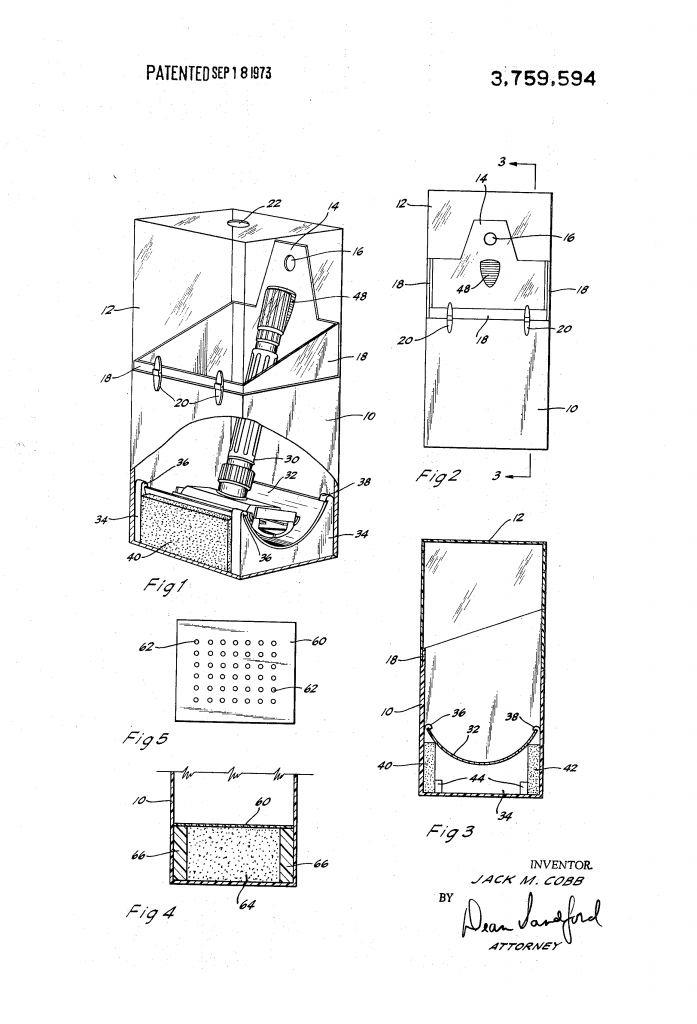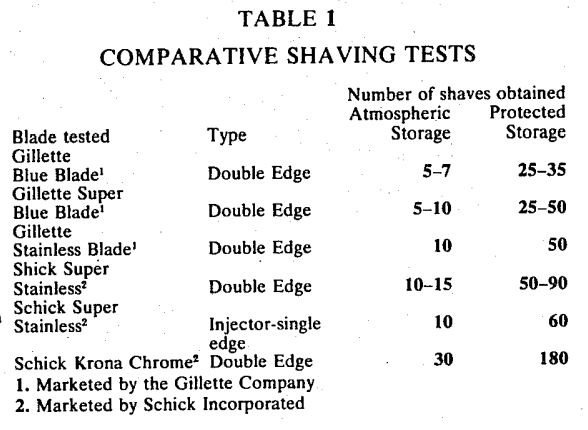Once you have a razor, it must be stored between shaves. And while I’ve looked at a number of cabinets and other solutions before, I think this is the first one made to keep your razor dry and corrosion free. Filed in ’71 by Jack Cobb, the apparatus for storing cutting implements looks sensible – and pointless.
So what problem, real or imaginary, did Jack set out to solve? In the words of his patent:
This invention relates generally to the field of cutting implements, and more particularly to methods and apparatus for preventing deterioration of the cutting edge of a cutting implement during storage between intermittent uses. One specific embodiment of the invention relates to a method and apparatus for storing a safety razor between shaving operations that maintains the cutting edge of the razor blade substantially indefinitely in the same condition that it is in after completion of the shaving operation.
From US patent 3,759,594
In short, a way to keep the edge of your razor longer. Personally I find that rinsing my razor with hot water and shaking it dry works well, but I’m using modern, stainless blades. For a carbon steel blade, this may not be enough. Or as it says in the patent text:
In the case of razor blades, it is common experience, particularly when steel safety razor blades are used, to obtain a smooth and comfortable shave the first time that a new blade is used, yet a short time later find that the same blade is dull and all but impossible to use. This deterioration of the cutting edge of a razor blade is not only rapid, but appears to take place whether the blade is merely rinsed after being used or is rinsed and carefully dried.
From US patent 3,759,594

The invention itself is a box. At the bottom of the box is a reservoir of a volatile corrosion inhibitor. The razor would be stored with the blade in close proximity, but not in contact with, said reservoir. The volatile corrosion inhibitor would be either a solid block, or a liquid absorbed in a wicking material. The The lid of the box would have a vent to let humidity out.
The patent goes into some detail outlining what kind of corrosion inhibitors could be used, such as alkali metal nitrites, various phosphates, organic nitrites, nitrous acid salts, and other fun compounds. The patent actually gives a long list of organic nitrites that could be employed… It reads like a cross between a chemistry text book and a chemical warfare book. Several of the compounds mentioned are known human carcinogens. I assume Cobb was unaware of this when he suggested them.
Interestingly enough, the patent also refers to a series of shaving tests conducted to compare the various blades and the effect of the apparatus for storing cutting implements. And while there may have been a bit (or a lot) of confirmation bias in the results, they are intriguing.

The results should be self evident. Or perhaps not, since most of us still store our razor in open air.
As an interesting side note, the razor depicted in the patent drawings seems to be a Gillette Slim Adjustable. I find it to be a very nice razor, although I never leave a blade in for more than a week of shaves.
You can read the full patent text at Google Patents. And if you enjoy old and weird shaving patents, why not check out the long list of blogposts I’ve made about them?

Pingback: Method and apparatus for storing cutting implements - Razors n Blades the shave that saves